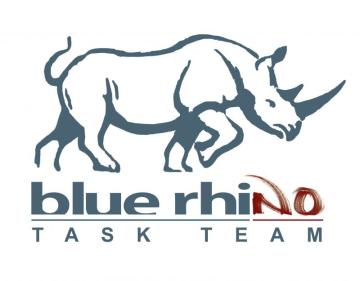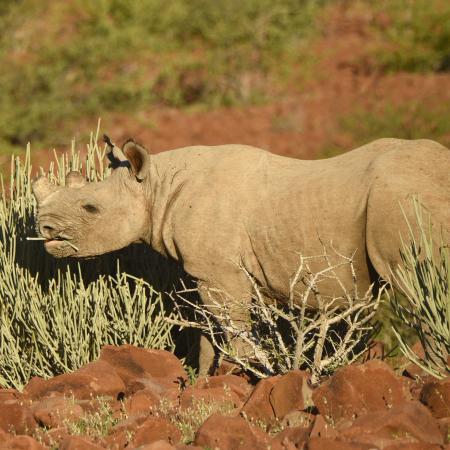
Lucha contra la caza furtiva y el tráfico de productos ilegales de la fauna y flora silvestres para apoyar la protección de la biodiversidad mediante la Operación Rinoceronte Azul.

La Operación Rinoceronte Azul se inició en 2018 para contrarrestar el aumento de los delitos contra la vida silvestre de alto valor en Namibia. La cooperación formal entre los ministerios gubernamentales es posible gracias a la financiación externa. Blue Rhino se facilita mediante la colaboración activa entre numerosas organizaciones asociadas. La protección de la biodiversidad en Namibia se basa en sistemas de conservación eficaces que permiten la existencia de poblaciones sanas de animales salvajes. Las iniciativas contra la caza furtiva protegen de los efectos delictivos sobre la fauna vulnerable. La aplicación de la ley y el enjuiciamiento frustran las actividades delictivas para salvaguardar los objetivos nacionales. La Operación Rinoceronte Azul trabaja en este marco para erradicar la caza furtiva comercial y el tráfico de productos ilegales derivados de la fauna y flora silvestres, apoyando así la protección de la biodiversidad de Namibia. La operación está dirigida por un grupo operativo especializado, el Blue Rhino Task Team, compuesto por investigadores policiales y personal de conservación. La operación "Rinoceronte Azul" se basa en los cimientos y en los esfuerzos constantes de la policía regional y de las unidades de conservación.
Contexto
Défis à relever
Durante la última década, Namibia se enfrentó a una escalada de delitos contra la vida silvestre, especialmente contra especies de gran valor como el elefante, el rinoceronte blanco y el rinoceronte negro, y el pangolín. En 2015/16 se registraron picos de caza furtiva de elefantes y rinocerontes. Los sólidos sistemas de conservación de Namibia y las saludables poblaciones de fauna silvestre limitaron los impactos, pero la caza furtiva amenazó a las vulnerables poblaciones de rinocerontes distribuidas por zonas de conservación estatales, comunitarias y privadas. Algunas poblaciones pequeñas y aisladas de rinocerontes desaparecieron por completo. Esto afectó a las industrias del turismo y la caza de conservación, así como a los medios de subsistencia rurales. El coste de la protección de los rinocerontes contra los cazadores furtivos amenazaba con hacer económicamente inviables las reservas privadas. El gobierno de Namibia colaboró con ONG, el sector privado y las comunidades locales para invertir esta tendencia. Las fuerzas de seguridad nacionales se han desplegado en los parques nacionales en funciones de lucha contra la caza furtiva desde 2016. Desde 2018, la aplicación de la ley contra los delitos contra la vida silvestre se ha transformado significativamente gracias a la labor de la Operación Rinoceronte Azul.
Ubicación
Procesar
Resumen del proceso
El gobierno de Namibia tiene el mandato de proteger la biodiversidad del país, hacer cumplir sus leyes, defender el Estado y sus recursos frente a las amenazas y realizar otras muchas actividades relacionadas con la protección de la vida silvestre y la aplicación de la ley. Para ser eficaces a largo plazo, los esfuerzos para combatir los delitos contra la vida silvestre deben trabajar directamente a través de los organismos gubernamentales competentes. En este sentido, la cooperación entre organismos constituye la base fundamental para el éxito de las intervenciones. Una financiación externa directa, rápida y flexible puede colmar las lagunas de financiación y eliminar los obstáculos burocráticos dentro del gobierno para liberar todo el potencial del personal para llevar a cabo eficazmente las actividades de conservación y aplicación de la ley que le han sido encomendadas. El uso de todas las tecnologías y herramientas disponibles proporciona una ventaja operativa, mientras que la planificación estratégica y la acción innovadora garantizan que los esfuerzos estén centrados y coordinados, y que las actividades puedan adaptarse a los cambios según sea necesario.
Los delincuentes tienen la ventaja de que pueden operar más allá de todas las fronteras, sin normas ni reglamentos, atacar rápidamente cuando les conviene y recibir recompensas directas, a menudo importantes. Mediante la interacción de los componentes descritos, las intervenciones de conservación y de aplicación de la ley pueden ganar la partida a los delincuentes.
Bloques de construcción
Cooperación interinstitucional
Los organismos gubernamentales suelen trabajar aislados de otros organismos gubernamentales, así como de organizaciones no gubernamentales, entidades del sector privado, comunidades locales y otros socios potenciales. La cooperación interinstitucional garantiza que distintos organismos con mandatos o intereses que se solapan actúen de enlace y colaboren entre sí para abordar objetivos comunes. El Ministerio de Medio Ambiente, Silvicultura y Turismo es el custodio de la fauna y flora silvestres y otros recursos terrestres de Namibia, y tiene el mandato de conservarlos y protegerlos. La Policía de Namibia tiene el mandato de mantener la ley y el orden, incluidas las leyes relacionadas con la vida silvestre. Las Fuerzas de Defensa de Namibia se encargan de defender al Estado y sus recursos frente a las amenazas. La Fiscalía General es responsable de procesar a los sospechosos en nombre del Estado en los procedimientos penales. Otros organismos gubernamentales con cierto solapamiento de mandato son la Dirección de Aduanas e Impuestos Especiales, el Centro de Inteligencia Financiera y la Comisión Anticorrupción. Las acciones del gobierno pueden reforzarse considerablemente mediante asociaciones con ONG, el sector privado, las comunidades locales y los organismos internacionales de financiación. La colaboración activa entre los organismos gubernamentales, y entre el gobierno y otras partes interesadas, facilita la lucha eficaz contra los delitos contra la vida silvestre en Namibia.
Factores facilitadores
- Compromiso pleno de todos los niveles de gobierno
- Mandatos claros de los organismos con objetivos comunes
- Comunicación activa y continua y puesta en común de recursos
- Relaciones de trabajo sólidas entre las personas clave
- Confianza en la integridad y competencia de las personas y organizaciones
- Pleno reconocimiento de las contribuciones individuales
- Reconocimiento de las funciones definidas a nivel individual y organizativo
- Desarrollo de capacidades y capacitación a todos los niveles
- Financiación externa y apoyo técnico rápidos y flexibles
- Reconocimiento de las partes interesadas y apoyo a los mandatos gubernamentales
Lección aprendida
- La cooperación entre agencias debe formalizarse mediante memorandos escritos en los que se definan los objetivos.
- La cooperación entre agencias requiere estructuras claras, cadenas de mando y confianza mutua.
- Deben definirse claramente las funciones y responsabilidades a nivel individual y organizativo.
- En el trabajo conjunto, cada organismo debe respetar y cumplir los requisitos de su mandato particular.
- Hay que evitar que las agencias o los individuos se extralimiten.
- La cooperación eficaz se construye a través de un enlace activo y continuo entre las personas clave de las distintas entidades.
- Deben superarse las limitaciones de financiación y capacidad del gobierno
- El apoyo financiero externo rápido y flexible directamente a las operaciones gubernamentales de aplicación de la ley libera todo el potencial y motiva a los individuos.
- Lo ideal es una buena combinación de apoyo de organismos de financiación internacionales y fuentes de financiación locales que salven las lagunas gubernamentales
- El pleno reconocimiento de todas las contribuciones es vital para lograr un amplio compromiso y apoyo.
- La comunicación activa y el intercambio de datos y recursos son vitales para el éxito.
- El intercambio de recursos entre unidades se basa en la confianza.
Apoyo financiero externo directo, rápido y flexible para las necesidades policiales y afines
Una gran parte de la financiación internacional para combatir los delitos contra la vida silvestre se destina a talleres y conferencias, concienciación y movilización de la comunidad, equipamiento general e infraestructuras, y gastos generales de las ONG ejecutoras. Las condiciones de uso de estos fondos suelen estar dictadas por el organismo financiador y la ONG ejecutora, y no por el gobierno del país destinatario. Aunque estas intervenciones desempeñan un papel importante, por lo general no abordan directamente el reto principal de la lucha contra los delitos contra la vida silvestre. Los organismos gubernamentales suelen funcionar con presupuestos limitados y procedimientos de adquisición y aprobación restrictivos. Esto puede impedir una actuación rápida, especialmente en situaciones de crisis imprevistas. Un apoyo financiero externo rápido y flexible que se canalice directamente hacia las operaciones gubernamentales puede eliminar muchas de estas limitaciones y liberar todo el potencial del personal gubernamental. En el contexto de la lucha contra los delitos contra la vida silvestre, esto permite al personal gubernamental encargado de la aplicación de la ley y de la conservación responder rápidamente a incidentes de cualquier naturaleza y llevar a cabo eficazmente las tareas que les han sido encomendadas. Es importante que los fondos se canalicen directamente hacia actividades operativas, idealmente a través de una ONG de apoyo local con unos gastos generales mínimos, en lugar de formar parte de presupuestos más amplios propensos a escollos burocráticos.
Factores facilitadores
- Voluntad del Gobierno de recibir financiación externa directa para actividades de protección de la vida silvestre y aplicación de la ley
- Agencia de financiación internacional con parámetros de financiación flexibles
- ONG de apoyo local en la que confíe el gobierno y con un historial probado en la lucha contra los delitos contra la vida silvestre para que actúe como conducto de financiación con unos gastos generales mínimos.
- Desarrollo de capacidades y capacitación individual del personal gubernamental encargado de la aplicación de la ley y de la conservación para que puedan llevar a cabo eficazmente las tareas encomendadas.
Lección aprendida
- Es importante contar con una ONG de apoyo local de confianza, con experiencia y conocimiento del entorno operativo, para garantizar la financiación internacional y canalizarla hacia operaciones gubernamentales prioritarias.
- La financiación debe destinarse directamente a las actividades gubernamentales de protección de la fauna y la aplicación de la ley.
- La financiación debe poder desembolsarse cuando sea necesario, 24 horas al día, 365 días al año, para garantizar una capacidad de respuesta rápida en todo momento.
- Las pequeñas iniciativas piloto son valiosas para probar sistemas y enfoques
- Las relaciones sólidas entre el personal clave son vitales para lograr los resultados deseados
Utilización de todas las tecnologías y herramientas disponibles
Los delincuentes adaptan constantemente sus actividades a las circunstancias cambiantes. Por tanto, es vital que las actividades de lucha contra la delincuencia también se adapten. Existe una gran variedad de tecnologías modernas que pueden mejorar considerablemente las iniciativas de lucha contra los delitos contra la vida silvestre. Éstas pueden combinarse con una serie de instrumentos tradicionales y novedosos de conservación y aplicación de la ley para proporcionar una ventaja operativa sobre las actividades delictivas. La innovación constante en el desarrollo de tecnologías y herramientas requiere una actualización periódica para mantenerse al día de los cambios. También es posible modificar tanto las tecnologías como las herramientas a nivel local para adaptarlas a las necesidades y aplicaciones únicas que vayan surgiendo.
En el ámbito de la aplicación de la ley en relación con los delitos contra la vida silvestre, las categorías tecnológicas vitales incluyen la vigilancia, la medicina forense (ADN, balística, digital), la captura/gestión/análisis de datos, y otras. Las herramientas incluyen redes de información, técnicas de investigación, técnicas de enjuiciamiento, seguimiento de causas judiciales, opciones legislativas, etc.
La aplicación eficaz de estas tecnologías y herramientas requiere el desarrollo de capacidades dentro del gobierno, así como la capacitación del personal individual para aplicar las tecnologías y herramientas según sea necesario.
Factores facilitadores
- Parámetros gubernamentales para aplicar eficazmente el uso de las tecnologías y herramientas disponibles.
- Financiación para obtener las últimas tecnologías y herramientas y actualizarlas según sea necesario.
- Desarrollo de capacidades para garantizar que las tecnologías y herramientas se utilicen de la mejor manera posible.
Lección aprendida
- Las tecnologías y herramientas sólo son valiosas si pueden ser aplicadas por personal competente y dedicado.
- Las tecnologías y herramientas deben ser compartidas por todas las partes interesadas para garantizar su mejor aplicación.
- El establecimiento de relaciones entre el personal de todos los organismos pertinentes es importante para garantizar que todos los agentes implicados adopten las tecnologías y herramientas.
- Las actitudes elitistas ante el uso de tecnologías y herramientas suelen ser contraproducentes.
- La capacidad de adaptar las tecnologías y herramientas a las necesidades y circunstancias locales puede cambiar las reglas del juego.
Planificación estratégica y acción innovadora
A largo plazo, las intervenciones para combatir los delitos contra la vida silvestre sólo pueden ser eficaces si se basan en una combinación de planificación estratégica y acción innovadora. Las estrategias prácticas con objetivos claramente definidos son vitales para permitir intervenciones coordinadas. Todas las intervenciones deben tratar de lograr los resultados necesarios para alcanzar los objetivos prioritarios. Para tener éxito, la planificación estratégica, así como las intervenciones resultantes, deben implicar a todos los actores clave para garantizar un sentimiento de propiedad conjunta. Del mismo modo, las intervenciones estratégicas deben incluir las contribuciones de todas las partes interesadas para garantizar una acción coordinada. Sin embargo, la acción debe seguir siendo innovadora para que las actividades puedan adaptarse a medida que surjan circunstancias imprevistas, surjan nuevas necesidades o cambien los parámetros. Además, las estrategias deben revisarse y perfeccionarse a intervalos regulares para garantizar que siguen siendo pertinentes en un entorno cambiante. Esta combinación de trabajo en pos de objetivos claros con estrategias eficaces, al tiempo que se está siempre dispuesto y se es capaz de adaptarse mediante cambios innovadores en el enfoque y la acción, es un elemento esencial para luchar eficazmente contra los delitos contra la vida silvestre.
Factores facilitadores
- Deben establecerse sistemas y enfoques sólidos para crear un marco eficaz de planificación estratégica y acción innovadora.
- Todas las partes interesadas deben participar en la planificación estratégica para garantizar un sentimiento de propiedad conjunta y permitir una aplicación satisfactoria.
- Una asociación sólida entre los organismos de conservación y los encargados de hacer cumplir la ley es vital para coordinar las estrategias de lucha contra los delitos contra la vida silvestre.
- La definición clara de los objetivos generales y de los resultados requeridos permite que la planificación estratégica sea pertinente y aplicable.
Lección aprendida
- Las estrategias sólo tienen éxito si son aceptadas por todas las partes interesadas y pueden aplicarse eficazmente.
- Las estrategias deben ser realistas, prácticas y alcanzables.
- Es importante reconocer todas las contribuciones a la aplicación de una estrategia.
- Las estrategias deben revisarse y perfeccionarse periódicamente para que sigan siendo pertinentes.
- La innovación y la adaptabilidad para cambiar las estrategias según las necesidades son vitales para el éxito continuo
- Puede ser necesario revisar los sistemas y enfoques existentes para permitir la aplicación de las estrategias o garantizar la innovación y la adaptabilidad.
Impactos
Durante los tres primeros años de la Operación Rinoceronte Azul, las fuerzas de seguridad de Namibia pasaron de una actuación reactiva a otra proactiva. La vigilancia, el análisis y otras capacidades tecnológicas, así como las redes de información conexas, mejoraron enormemente. La detección precoz de actividades delictivas ha permitido realizar detenciones preventivas y responder con rapidez a los incidentes. Las investigaciones sistemáticas siguen dando resultados en casos antiguos, y se sigue deteniendo a los autores años después de los incidentes. La rápida detención de infiltrados, incluidos miembros de las fuerzas de seguridad de Namibia implicados en delitos contra la vida silvestre, ha dejado claro que nadie está por encima de la ley. La mejora de la gestión de los casos, la preparación de los tribunales y el seguimiento judicial han dado lugar a un aumento de las tasas de condena y a penas más adecuadas. Estas intervenciones han transformado la aplicación de la ley en Namibia. Los resultados son los siguientes:
- aplicación de la ley proactiva y basada en pruebas
- consolidación, gestión y análisis de los datos de los organismos pertinentes a través de una base de datos integrada sobre delitos contra la vida silvestre
- creación de redes de información eficaces
- aumento significativo de las detenciones e incautaciones
- detenciones preventivas que salvan a numerosos rinocerontes
- detención de traficantes y cabecillas de alto nivel
- colaboración activa con la Unidad de Delitos contra el Medio Ambiente de la Fiscalía General, lo que refuerza significativamente el enjuiciamiento
- reducción significativa de la caza furtiva de elefantes y rinocerontes
- capacitación continua del personal
Beneficiarios
- Biodiversidad de Namibia
- Poblaciones de elefantes, rinocerontes y pangolines
- Población de Namibia
- Gobierno de Namibia
- Industria turística
- Industria de la caza de conservación
- Áreas protegidas estatales, comunitarias y privadas
- Iniciativas sudafricanas contra el tráfico de seres humanos
Objetivos de Desarrollo Sostenible
Historia

Las detenciones preventivas de posibles cazadores furtivos de rinocerontes se encuentran entre las más satisfactorias e inspiradoras de todas las intervenciones de Blue Rhino. Representan uno de los mejores resultados que se puede esperar en materia de aplicación de la ley en relación con la caza furtiva y el tráfico de rinocerontes. En los últimos años, la aplicación preventiva de la ley ha cambiado las reglas del juego para contrarrestar los delitos contra los rinocerontes y facilitar la protección de las poblaciones de rinocerontes de Namibia. Entre principios de 2018 y finales de 2021, 42 casos preventivos relacionados con rinocerontes han llevado a la detención de 161 sospechosos. Estos son resultados impresionantes en materia de aplicación de la ley. También son resultados de conservación extremadamente importantes.
Las detenciones preventivas detienen a los autores cuando están planeando o intentando cometer un delito, pero aún no han podido matar a un animal. Las detenciones están salvando a numerosos rinocerontes, pero siguen deteniendo y condenando a los delincuentes, lo que constituye un importante factor disuasorio de la caza furtiva. El efecto en cadena de la desarticulación de grupos enteros de traficantes significa que con cada detención preventiva se salva un número considerable de rinocerontes. El resultado es una combinación de éxitos policiales y resultados positivos para la conservación.
Al principio de la oleada de caza furtiva en Namibia, la aplicación de la ley se llevaba a cabo principalmente como reacción al descubrimiento de animales muertos o a la incautación oportunista de productos derivados de la fauna silvestre. Gracias a las investigaciones proactivas, la cooperación entre organismos, la financiación rápida y flexible, el uso de las últimas tecnologías de vigilancia y análisis, y la información y el apoyo de la comunidad, ahora se detiene regularmente a los furtivos y se les acusa de conspiración para la caza furtiva antes de que consigan matar a un rinoceronte. Detener a los autores y, al mismo tiempo, mantener a salvo a los rinocerontes es un logro personal especialmente satisfactorio para el personal encargado de la aplicación de la ley y de la conservación.
Según la legislación namibia, las leyes y penas relativas a la conspiración para cometer un delito (en este caso la caza furtiva de rinocerontes) se aplican del mismo modo que si el autor hubiera cometido el delito propiamente dicho. Los sospechosos en las detenciones preventivas son acusados de conspiración para cazar furtivamente rinocerontes (también conocido como intento de caza furtiva). Los cargos en los casos de detención preventiva se basan en diversas pruebas incriminatorias, que pueden incluir la entrada ilegal en un parque de caza, la posesión de armas de fuego ilegales, el porte de armas de fuego en un parque de caza, etc. Es importante que las sentencias dictadas por los tribunales reconozcan la gravedad de los delitos como equiparables a la caza furtiva real.



